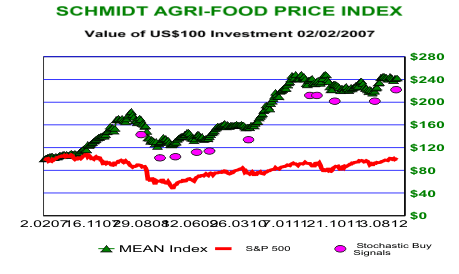Why Soybeans Beat iPads
Commodities / Agricultural Commodities Oct 25, 2012 - 02:16 AM GMTBy: Ned_W_Schmidt
 Technology businesses have always seemed to this researcher to be a losers' game. Soybeans, in the past decade or so, have been converted to a winning game. Why play with losers when one can play with winners? The simple, but elegant, reason soybeans are a better bet than iPads is the cost structure of the two businesses. One is desirable and one is not. The reason soybeans are better is that the cost structure in the industry is now fundamentally better than that of technology.
Technology businesses have always seemed to this researcher to be a losers' game. Soybeans, in the past decade or so, have been converted to a winning game. Why play with losers when one can play with winners? The simple, but elegant, reason soybeans are a better bet than iPads is the cost structure of the two businesses. One is desirable and one is not. The reason soybeans are better is that the cost structure in the industry is now fundamentally better than that of technology.
Chart below is our Agri-Food Price Index. That measure is just shy of a new high. Now, what would a chart of technology product prices look like? Would it have an uptrend or a sickly looking down trend? To help in answering that question think about those technology products you have bought. Did you pay more or less for the latest one when compared to your previous purchase? Is the price of steaks going up or down? Most of the articles discussing the new MSFT and AAPL products focus on two aspects, price and features. The worry is that they will not be sufficiently low priced to attract consumers. We do not seem to face that problem with soybeans.

The long-run cost curve for technology has a declining trend. The cost to produce any technology declines over time as manufacturers move up the learning curve and develop new production methods. In short, the marginal costs of producing technology declines over time. iPads are not yet sold in bubble wraps at convenience stores, but give it time.
The situation in soybeans, or steaks, is now the opposite. Having put to work most of the best arable land, the world is now facing a rising marginal cost of producing soybeans and steaks. New land is less productive and the water resources available not as good. The marginal cost of producing those soybeans and steaks is rising. The beauty in that is the consumer must pay the required higher price for all soybeans and steaks, not just the new production at the margin. That is if they choose to eat.
Chart above is of the stock price trends of the top tier Agri-Equities. These companies are generally larger, multinational companies or firms dominant in their industry. That price index of Tier One Agri-Equities closed out September at a new high, albeit not a major one. Over the same time as that chart shows the equity market has been generally stagnant.
For most of modern times economists and strategists have always warned that Agri-Commodity prices go up and down. That statement is

true, but ignores an important new factor. Agri-Commodity prices now have a secular uptrend about which they move. That underlying, positive trend is due to the rising population of middle class consumers in Asia and Pacific that now earn sufficient incomes to eat as they please. Those with the money dictate the prices. Western consumers, with incomes crushed by Keynesian nonsense, will get what is left, if they can afford it.
Investors can continue to read redundant drivel on the next over priced technology product or such nonsense as Facebook. Or, they can research Agri-Equities which may allow them to continue to afford food in the future. No shortage of tablets is to occur, but a shortage of palm oil seems inevitable. Which companies produce that all important vegetable oil?
By Ned W Schmidt CFA, CEBS
AGRI-FOOD THOUGHTS is from Ned W. Schmidt,CFA,CEBS, publisher of The Agri-Food Value View, a monthly exploration of the Agri-Food grand cycle being created by China, India, and Eco-energy. To contract Ned or to learn more, use this link: www.agrifoodvalueview.com.
Copyright © 2012 Ned W. Schmidt - All Rights Reserved
Ned W Schmidt Archive |
© 2005-2022 http://www.MarketOracle.co.uk - The Market Oracle is a FREE Daily Financial Markets Analysis & Forecasting online publication.



